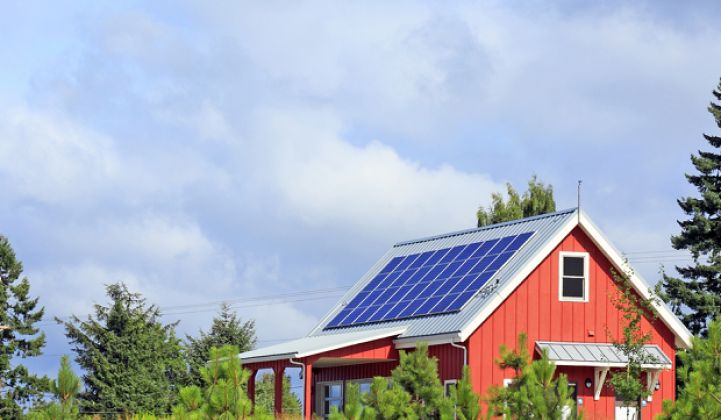A chill has hit home solar. According to GTM Research’s latest U.S. Solar Market Insight report, Q3 2017 was the third consecutive quarter that the residential solar market fell by installation volume.
It's easy to blame the “big three” for this downturn -- collectively, SolarCity, Vivint Solar and Sunrun (excluding Sunrun's channel business) are down 32 percent in installation volume over the first three quarters of 2016, according to the latest U.S. PV Leaderboard.
At the same time, we talk about the rest of the market -- the long tail -- as though it were an aggregate force tempering the downfalls of the behemoth big three.
But what is really going on with the long tail? The long tail has been gradually gaining market share each quarter and now holds 70 percent of it, its highest share in four years. But this doesn’t paint a full picture.
Today, the long tail consists of nearly 3,000 active and distinct residential solar installation companies. Surely the strengths and operations of these individual companies cannot be in sync.
We can examine the residential solar market in California, the largest state market in the country, to get a glimpse at just how the long tail is doing.
FIGURE: Installation Growth by Solar Company Type in California, Q1-Q3 2017 Over Q1-Q3 2016

Source: GTM Research U.S. Downstream Distributed Solar Service
As shown above, the downturn in the California residential market was not only a function of installation declines by SolarCity, Vivint Solar and Sunrun. Rather, installers of all sizes fell collectively in the number of installations from last year.
Mid- to large-sized solar companies (defined for the purpose of this analysis as companies with a run rate of more than 200 installations in 2017) fell by more than 4,000 installations over last year. Smaller companies, many of which specialize in other services but also do solar installations, fell by more than 6,000 installations. In fact, the only installers that collectively grew in terms of number of installations were those that were new to the California market in 2017.
This picture makes the outlook for these new solar installers look pretty bleak. But again, the graph above uses a blunt grouping of companies, and not every company within each group gained or lost like the others.
FIGURE: Percentage of California Residential Solar Installers Growing by Installer Size, Q1-Q3 2017 Over Q1-Q3 2016
Source: GTM Research U.S. Downstream Distributed Solar Service
On the positive side, more than half of all solar installers doing more than 200 annual installations that were active in both 2016 and 2017 grew this year by number of installations. And if we dig deeper, the sweet spot for installation growth in California appears to be for companies in the 400 to 600 annual installation size range (equating to between about 3 and 4 megawatts of capacity installed annually). For companies larger than this, as shown above, the prospect for growth diminishes incrementally.
So what is it that distinguishes the companies that are growing from the ones that are not? This question is at the forefront of many minds as financiers, O&M providers, equipment suppliers and others seek to partner with growing (or at least stable) companies.
Perhaps the differences in success could be pinned to product offering. According to GTM Research’s U.S. Residential Solar Finance H2 2017 report, loans are quickly eclipsing lease and PPA offerings, which will make up just 37 percent of the residential market in 2017, down from 53 percent in 2016. It could be that companies selling loans are better positioned to deliver value to customers and therefore have greater growth prospects.
However, of the solar companies shown above that are growing, there is a wide range of product mixes. Of the companies that are growing in California, some do not offer any leases or PPAs, some sell as much as 98 percent of their systems with a lease or PPA, and others have a healthy mix of offerings. The average third-party ownership percentage for these growing companies is just over 30 percent -- lower than the national average, but not by much.
There is no "silver bullet" when it comes to mix of product offerings. The key to healthy growth is not what a company is selling, but how it is selling it. The particular success of companies in the 400 to 600 annual installation range indicates that it is difficult to scale companies that are very small or very large.
It is difficult for a really small solar installer to build brand awareness and acquire customers. But after a certain size, the company has generally built a strong referral network, at which point it has a good chance at growth -- that is, if it can keep customer-acquisition costs low and design a sales channel mix that works for that particular business.
The long-held belief that customer acquisition is hard and plagues companies of all sizes still holds true, and the companies that can master it -- perhaps most easily done by mid-sized installation companies -- have the most promising outlook.
***
Want to learn more about which solar companies are growing, where they are doing installations, and what products they are selling? GTM Research’s Solar Data Hub allows clients to view and manipulate interconnection data down to the city level for the entire long tail, and more. Contact [email protected] for more information.




